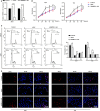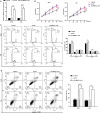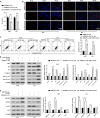LncRNA MBNL1-AS1 represses cell proliferation and enhances cell apoptosis via targeting miR-135a-5p/PHLPP2/FOXO1 axis in bladder cancer
- PMID: 31769229
- PMCID: PMC6970060
- DOI: 10.1002/cam4.2684
LncRNA MBNL1-AS1 represses cell proliferation and enhances cell apoptosis via targeting miR-135a-5p/PHLPP2/FOXO1 axis in bladder cancer
Abstract
LncRNAs have been shown to play essential roles in bladder cancer (BC) progress. Our microarrays of clinical samples firstly screened that lncRNA muscleblind-like 1 antisense RNA 1 (MBNL1-AS1) was poorly expressed in BC tissues. However, its biological function in BC remains not well understood. Here we examined the clinical correlations with MBNL1-AS1 in BC patients. Then, 5673 and T24 cell lines were employed to investigate the role of MBNL1-AS1 in the proliferation and apoptosis of BC cells in vitro and in vivo. Furthermore, miR-135a-5p (miR-135a)/PHLPP2/FOXO1 axis was focused to explore its regulatory mechanism in BC. The results showed that MBNL1-AS1 was significantly downregulated in bladder tumor tissues, and associated with BC progression. In vitro, MBNL1-AS1 knockdown increased the number of viable cells and bromodeoxyuridine-positive cells, accelerated cell cycle, and dysregulated proliferative regulators (Ki67, p21, p27, and Cyclin D1) in BC cells. The apoptotic cells and the cleavages of caspase-3/9 were reduced in MBNL1-AS1-silenced BC cells. Overexpression of MBNL1-AS1 had opposite effects on BC cell proliferation and apoptosis. Moreover miR-135a was demonstrated to interact with MBNL1-AS1, and inhibiting miR-135a reversed the effects of shMBNL1-AS1 on BC cells. The downstream effectors (PHLPP2 and FOXO1) were positively regulated by MBNL1-AS1, but negatively regulated by miR-135a. Similar results were also observed in xenograft tumors. In conclusion, this study firstly suggests that MBNL1-AS1 acts as a tumor suppressor of BC by targeting miR-135a/PHLPP2/FOXO1 axis, providing a novel insight for BC diagnosis and treatment.
Keywords: FOXO1; MBNL1-AS1; PHLPP2; bladder cancer; miR-135a-5p.
© 2019 The Authors. Cancer Medicine published by John Wiley & Sons Ltd.
Conflict of interest statement
The authors declare no conflict of interest.
Figures







Similar articles
-
Mir-135a enhances cellular proliferation through post-transcriptionally regulating PHLPP2 and FOXO1 in human bladder cancer.J Transl Med. 2015 Mar 13;13:86. doi: 10.1186/s12967-015-0438-8. J Transl Med. 2015. PMID: 25888950 Free PMC article.
-
Down-regulation of MBNL1-AS1 contributes to tumorigenesis of NSCLC via sponging miR-135a-5p.Biomed Pharmacother. 2020 May;125:109856. doi: 10.1016/j.biopha.2020.109856. Epub 2020 Feb 25. Biomed Pharmacother. 2020. PMID: 32092823
-
Long non-coding RNA ASMTL-AS1 inhibits tumor growth and glycolysis by regulating the miR-93-3p/miR-660/FOXO1 axis in papillary thyroid carcinoma.Life Sci. 2020 Mar 1;244:117298. doi: 10.1016/j.lfs.2020.117298. Epub 2020 Jan 14. Life Sci. 2020. PMID: 31953163
-
The Regulatory Role of Both MBNL1 and MBNL1-AS1 in Several Common Cancers.Curr Pharm Des. 2022;28(7):581-585. doi: 10.2174/1381612827666210830110732. Curr Pharm Des. 2022. PMID: 34459372 Review.
-
Noncoding RNAs as a potential biomarker for the prognosis of bladder cancer: a systematic review and meta-analysis.Expert Rev Mol Diagn. 2023 Apr;23(4):325-334. doi: 10.1080/14737159.2023.2195554. Epub 2023 Apr 19. Expert Rev Mol Diagn. 2023. PMID: 36970945
Cited by
-
MiR-135a-5p suppresses trophoblast proliferative, migratory, invasive, and angiogenic activity in the context of unexplained spontaneous abortion.Reprod Biol Endocrinol. 2022 May 24;20(1):82. doi: 10.1186/s12958-022-00952-z. Reprod Biol Endocrinol. 2022. PMID: 35610725 Free PMC article.
-
Long non-coding RNA muscleblind like splicing regulator 1 antisense RNA 1 (LncRNA MBNL1-AS1) promotes the progression of acute myocardial infarction by regulating the microRNA-132-3p/SRY-related high-mobility-group box 4 (SOX4) axis.Bioengineered. 2022 Jan;13(1):1424-1435. doi: 10.1080/21655979.2021.2018974. Bioengineered. 2022. Retraction in: Bioengineered. 2024 Dec;15(1):2299561. doi: 10.1080/21655979.2024.2299561. PMID: 34978261 Free PMC article. Retracted.
-
Long non‑coding RNA 00858 knockdown alleviates bladder cancer via regulation of the miR‑3064‑5p/CTGF axis.Oncol Rep. 2021 Aug;46(2):164. doi: 10.3892/or.2021.8115. Epub 2021 Jun 16. Oncol Rep. 2021. PMID: 34132366 Free PMC article.
-
Downregulation of lncRNA FGF12-AS2 suppresses the tumorigenesis of NSCLC via sponging miR-188-3p.Open Med (Wars). 2020 Oct 8;15(1):986-996. doi: 10.1515/med-2020-0219. eCollection 2020. Open Med (Wars). 2020. PMID: 33344773 Free PMC article.
-
LncRNA MBNL1-AS1 Suppresses Cell Proliferation and Metastasis of Pancreatic Adenocarcinoma through Targeting Carcinogenic miR-301b-3p.Genet Res (Camb). 2023 Mar 1;2023:6785005. doi: 10.1155/2023/6785005. eCollection 2023. Genet Res (Camb). 2023. PMID: 36908851 Free PMC article.
References
-
- DeGeorge KC, Holt HR, Hodges SC. Bladder cancer: diagnosis and treatment. Am Fam Physician. 2017;96(8):507‐514. - PubMed
-
- Jemal A, Siegel R, Ward E, et al. Cancer statistics, 2008. CA Cancer J Clin. 2008;58(2):71‐96. - PubMed
-
- Albers P. Words of wisdom. Re: cystectomy for transitional cell carcinoma of the bladder: results of a surgery only series in the neobladder era. Eur Urol. 2008;53(1):208‐209. - PubMed
-
- Stein JP, Lieskovsky G, Cote R, et al. Radical cystectomy in the treatment of invasive bladder cancer: long‐term results in 1054 patients. J Clin Oncol. 2001;19(3):666‐675. - PubMed
-
- von der Maase H, Sengelov L, Roberts JT, et al. Long‐term survival results of a randomized trial comparing gemcitabine plus cisplatin, with methotrexate, vinblastine, doxorubicin, plus cisplatin in patients with bladder cancer. J Clin Oncol. 2005;23(21):4602‐4608. - PubMed
Publication types
MeSH terms
Substances
LinkOut - more resources
Full Text Sources
Medical
Research Materials
Miscellaneous

